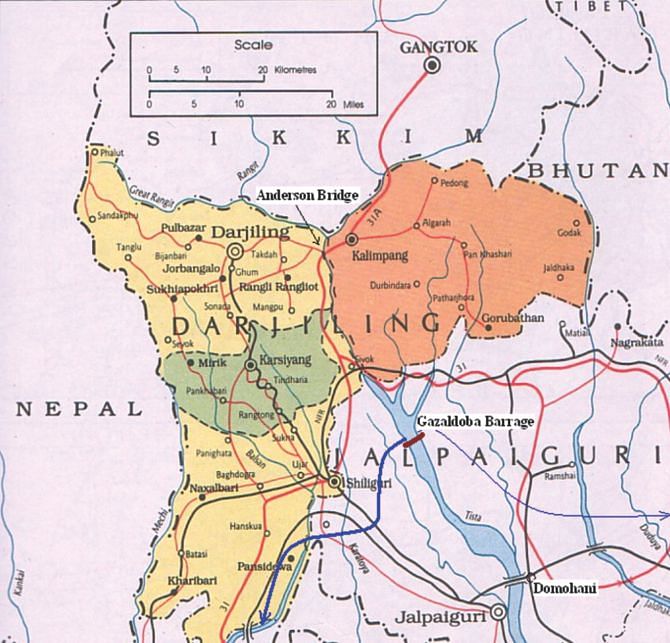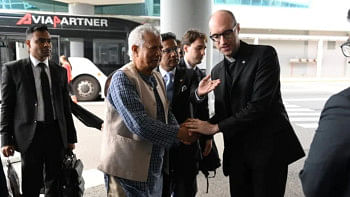How far is Teesta water sharing agreement?

BANGLADESH Foreign Minister A.H. Mahmood Ali and his team recently met with his Indian counterpart Sushma Swaraj and other Indian officials in New Delhi. A 36-point joint statement on the meeting, called `Joint Statement on the Third Meeting of the India-Bangladesh Joint Consultative Commission,' was issued on September 20. The statement referred to the Teesta and Feni River water sharing problems in its Article 24, and called for the finalisation of the Interim Agreement. Does it mean that the Teesta water agreement is not far?
Bangladesh Water Resources Minister Ramesh Chandra Roy demanded 50-50 distribution of the Teesta water at Gazaldoba point in the 37th meeting of the Joint Rivers Commission in Delhi. At that time he expressed satisfaction at getting 3,500 cusec of water without asking, and said that it could be increased through talks (The Daily Star, March 18, 2010). In January 2011, after a secretary level meeting, it was in the air that the Teesta water sharing agreement was imminent, with the formula of dividing the flow 50-50, keeping aside 20% of the total flow for the river. But the Hasina-Manmohan Summit in Dhaka on September 7, 2011, ended with no agreement on the Teesta water. It was reported in the media that Paschimbanga Chief Minister Mamata Banerjee wanted to give Bangladesh 25% share only, so the summit failed. On September 8, Foreign Affairs Secretary of Bangladesh Mijarul Quayes said at a press conference. “Teesta agreement is finalised; we are not to give any more concession.” Does the Bangladesh stand on Teesta waters still remain?
We got some contradictory standpoints from the Bangladesh government in the media. The then PM's advisor Mashiur Rahman said: “In fact we do not know how much water is flowing through the Teesta River. We are to measure it for 17 years, then after that the agreement shall be signed” (The Daily Star September 3, 2011). In that case, a deal in 2011 to measure the Teesta flow for 17 years was nothing but eyewash, not to benefit the people of Bangladesh anyway. In fact, the water of Teesta River flowing down from Sikkim is being obstructed by the Gazaldoba Barrage and being diverted by a link canal to the Mahananda-Mechi-Fulhar Rivers. This transfer of water from Brahmaputra basin to Ganga basin is unacceptable, and it violates the International Convention on Non-navigational uses of Watercourses of 1997 in force since August 17, 2014. Water of a river can be used on equitable basis where the minimum historical flow has to be maintained for the life of the river, and no harm can be caused to the other state.
The Watercourse Convention Article 7.1 states: “Watercourse States shall, in utilising an international watercourse in their territories, take all appropriate measures to prevent the causing of significant harm to other watercourse States.” Article 7.2 says: “Where significant harm nevertheless is caused to another watercourse State, the States whose use causes such harm shall, in the absence of agreement to such use, take all appropriate measures, having due regard for the provisions of Articles 5 and 6, in consultation with the affected State, to eliminate or mitigate such harm and, where appropriate, to discuss the question of compensation.” In Article 25 of the statement, the Indian side reiterated its earlier commitment that it would not take any unilateral decision on the Himalayan component of the proposed River Interlinking project which may adversely affect Bangladesh. This commitment should be reflected in the interim agreement to be signed on Teesta waters.
The Feni River has about 2,000 sq km (200,000 hectares) catchment area beyond Amlighat, of which 800 sq km is in India (Tripura) and 1,200 sq km is in Bangladesh. The Muhuri has about 800 sq km catchment area in India (Tripura) before it enters into Bangladesh, near Belonia. The Selonia River has origin in India having catchment of about 250 sq km in Tripura. India being militarily strong and having strong border surveillance, withdraws water from the Feni River by pumps for irrigation and water supply. Bangladesh, on the other hand, though a co-riparian nation, is being prevented by the Indian Border Security Forces from doing so. The Feni River has a large irrigation project in Feni and Chittagong districts with command area of 40,080 hectares. This project is being affected by the withdrawals in India. The Feni River has a historical annual and lean period flow. All withdrawals from this basin harm the ecology and economy.
The Feni River was discussed in the 37th India Bangladesh Joint Rivers Commission meeting held in New Delhi during March 17-20, 2010. Bangladesh agreed to allow 1.82 cumec (60 cusec) of water withdrawal by India for drinking purposes. This matter was to be discussed again in the 38th JRC meeting in Dhaka on September 5, 2011, for signing an agreement. The meeting was not held. The recent move to share the Feni River water was based on its lowest flow of 120 cusec on 50-50 basis. Bangladesh, though having larger geographical area, is offered 50-50 sharing of the Feni waters, which is not acceptable.
The writer is Chairman, Institute of Water & Environment.
Email: [email protected]

 For all latest news, follow The Daily Star's Google News channel.
For all latest news, follow The Daily Star's Google News channel. 



Comments